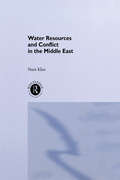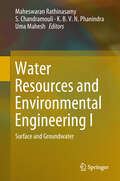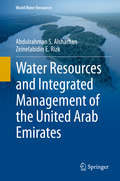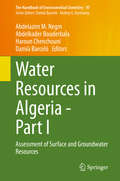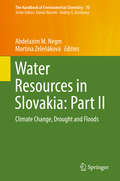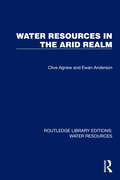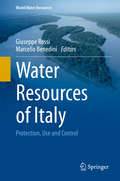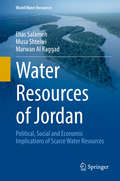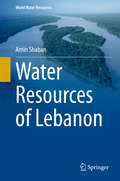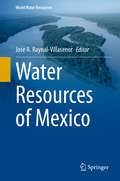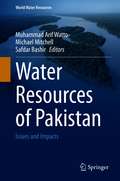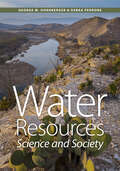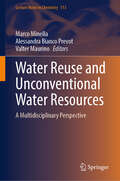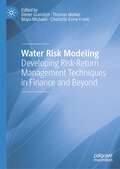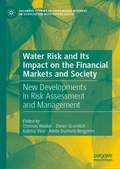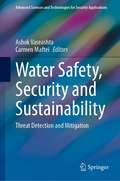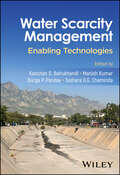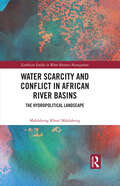- Table View
- List View
Water Resources and Conflict in the Middle East
by Nurit KliotThe Middle East is a region of international concern and political unrest. This book forms a complete reference to both the hydrological as well as the social, economic, political and legal issues in the region and shows how water shortages threaten the renewal of military conflicts and disruption in the area. With resources over-extended due to natural and human causes, the book analyses the river basins of the Euphrates, Tigris, Nile and Jordan and provides detailed study of the hydrology, hydrography and geography of these river basins; it also analyses the needs of the economies and societies of the countries bordering these basins. Conclusions on likely areas of conflict are set within the legal framework of the Helsinki and International Law Commission Rules.
Water Resources and Environmental Engineering I: Surface And Groundwater
by S. Chandramouli Maheswaran Rathinasamy Uma Mahesh K.B.V.N. PhanindraThe book is a compilation of the papers presented in the International Conference on Emerging Trends in Water Resources and Environmental Engineering (ETWREE 2017). The high quality papers are written by research scholars and academicians of prestigious institutes across India. The book discusses the challenges of water management due to misuse or abuse of water resources and the ever mounting challenges on use, reuse and conservation of water. It also discusses issues of water resources such as water quantity, quality, management and planning for the benefits of water resource scientists, faculties, policy makers, stake holders working in the water resources planning and management. The research content discussed in the book will be helpful for engineers to solve practical day to day problems related to water and environmental engineering.
Water Resources and Integrated Management of the United Arab Emirates (World Water Resources #3)
by Abdulrahman S. Alsharhan Zeinelabidin E. RizkThis book provides an inventory of water resources, describes water challenges, and suggests methodologies and technologies for integrated water resources management in the UAE. It also summarizes efforts of water conservation and management, and modern approaches for improvement of water resources management and decision-making related to this valuable resource. The authors are specialized in geology and hydrogeology and have been teaching and conducting scientific research on water resources in the UAE for the last three decades. This book represents the main reference on water resources in the UAE for academia, researchers, professionals, students and the general public.
Water Resources in Algeria - Part I: Assessment of Surface and Groundwater Resources (The Handbook of Environmental Chemistry #97)
by Damià Barceló Abdelazim M. Negm Haroun Chenchouni Abdelkader BouderbalaThis book reviews the latest information on the assessment of surface and groundwater resources in Algeria. The authors cover a large diversity of topics, including the status and assessment of water resources, impacts of pesticides, soil droughts, analysis of flood characteristics, hydrogeological investigations and modeling applications, and evapotranspiration. Special attention is given to the impacts of climate changes on water resources. The assessment methods present in this book can be used or adapted to study other regions of North Africa, Middle East and/or in the Mediterranean with similar climate conditions as Algeria.This book and the companion volume Water Resources in Algeria - Part II: Water Quality, Treatment, Protection and Development will appeal to engineers, researchers, graduate students and policymakers interested in the field of groundwater and surface water assessment.
Water Resources in Algeria - Part II: Water Quality, Treatment, Protection and Development (The Handbook of Environmental Chemistry #98)
by Damià Barceló Abdelazim M. Negm Haroun Chenchouni Abdelkader BouderbalaThis book reviews the latest water quality protection and water resources development strategies in Algeria. It covers topics such as the assessment and prediction of water quality, salt-water intrusion, treatment of wastewater for reuse, and desalination as an alternative source of water. The methods presented in this book can also be applied in other regions with similar climate conditions. Together with the companion volume Water Resources in Algeria - Part I: Assessment of Surface and Groundwater Resources, this book provides researchers with essential reference material on tools and techniques for water quality assessment, treatment, reuse, desalination, protection, and development, and offers a valuable resource for engineers, graduate students and policymakers who are interested in sustainable water resources.
Water Resources in Arid Lands: Management and Sustainability (Advances in Science, Technology & Innovation)
by Osman Abdalla Anvar Kacimov Mingjie Chen Ali Al-Maktoumi Talal Al-Hosni Slim Zekri Kaveh MadaniThis book presents the most recent innovative studies in the field of water resources for arid areas to move towards more sustainable management of the resources. It gathers outstanding contributions presented at the 2nd International Water Conference on Water Resources in Arid Areas (IWC), which was held online (Muscat, Oman) in November 2020. Papers discuss challenges and solutions to alleviate water resource scarcity in arid areas, including water resources management, the introduction of modern irrigation systems, natural groundwater recharge, construction of dams for artificial recharge, use of treated wastewater, and desalination technologies. As such, the book provides a platform for the exchange of recent advances in water resources research, which are essential to improving the critical water situation and to move towards more sustainable management of water resources.
Water Resources in Slovakia: Assessment And Development (The Handbook of Environmental Chemistry #69)
by Martina Zeleňáková Abdelazim M. NegmThis volume presents up-to-date information on the status and assessment of water resources in Slovakia and methods for their development. The major themes include key facts about Slovakian water resources, their assessment and development; water supply and demand; irrigation water; groundwater; water and sediment quality with a focus on mining water; wastewater management in Slovakia; and rainwater management. The book closes with general conclusions and recommendations for future research. It is a valuable resource for graduate students and researchers as well as for decision makers involved in sustainable development.
Water Resources in Slovakia: Climate Change, Drought And Floods (The Handbook of Environmental Chemistry #70)
by Martina Zeleňáková Abdelazim M. NegmThis book offers up-to-date information on the impact of climate change on water resources in Slovakia, the occurrence of drought and floods, hazards and protection methods. The topics covered include hydrological extremes, such as droughts and flood, in Slovakia; risk assessment and protection; sustainable management; and water management in buildings. The closing chapter provides general conclusions and recommendations for future research. It appeals to graduate students and researchers as well as to decision makers involved in planning future water resources in Slovakia.
Water Resources in the Arid Realm (Routledge Library Editions: Water Resources)
by Ewan Anderson Clive AgnewOriginally published in 1992, this book dispels some of the myths that surround water resource problems of arid lands and the notion that there are simple ‘once and for all’ solutions. Population growth, industrialization, environmental mismanagement and land degradation have led to droughts, poverty and famine with the result that the need for space, food and key natural resources such as water has become the most critical issue in global development. Nowhere is this crisis more apparent than in arid lands, where water resources provide the key to economic and environmental development. The authors argue that as the arid land environment is highly variable the key to success is flexibility. The book is divided into four sections, dealing with the geography of the arid realm; the water resource problems they face: the methods available for enhancing water supplies and finally, management of this resource. The book will be of use to undergraduate and postgraduate student and for those actively engaged in the development of arid land water resources.
Water Resources of Chile (World Water Resources #8)
by Bonifacio Fernández Jorge GironásChile is a privileged country in terms of water resources, with an average annual runoff of approximately 50,000 m3/person. However, water availability varies enormously in space, as less than 1,000 m3/person are available for more than 50% of the population. The temporal and spatial distribution of water resources is driven by processes highly variables across a country with different climates explained not only by a large range of latitudes (from 17° to 56° south), but also the presence of the Pacific Ocean and the Andes with peaks up to 7000 m. This geography makes of Chile a true natural laboratory in which water is essential for the society and the economy of the country. The relevance of water resources for the country has become even more significant in the context of a mega-drought that has affected practically the entire territory in recent years, although large floods such as those in Atacama 2015 and 2017 also take place periodically. This unique book brings together the state-of-art knowledge about the hydrology of Chile and its water resources, with a particular focus on quantitative aspects. The chapters are prepared by many of the most relevant researchers and practitioners working in water resources in the country. High-quality research contributions on climate and meteorology, surface and subsurface hydrology, water quality, water monitoring, water resource and global change, among other issues, are presented in this unique book, which offers a useful guide for academicians, researchers, practitioners and managers dealing with diverse water-related issues in Chile and other regions with similar characteristics
Water Resources of Italy: Protection, Use and Control (World Water Resources #5)
by Marcello Benedini Giuseppe RossiThis book offers a comprehensive framework of the current state of water resources in Italy and of the main stages of the evolutionary way in the last decades for achieving an integrated, sustainable and equitable water resources management. The main paradigms of water resources development are identified as: i) engineering and economic approach to water resources exploitation, ii) focus on pollution control and water-excess management, iii) a comprehensive approach toward a sustainable and equitable distribution of resources and effective risk reduction of water-related disasters. After a section devoted to the analysis of some historic stages in the legislation framework and the governance of water and soil, with particular reference to planning, design, building and operation of water systems, two sections deal with the estimation of water resources availability on national territory and estimation of water demands in municipal, agricultural, industrial, ecosystem sectors. The complex problems that the Italian society has to solve in the water field and the main challenges of a changing world are discussed in the fourth section of the volume. The book will not only be useful for water professionals, but also for citizen who like to discern the key factors which delay the recognition of water as a resource for life. The description of the problems and adopted solutions could also serve as a guideline for similar situations encountered in other countries, improving the preparation of the responsible people.
Water Resources of Jordan: Political, Social And Economic Implications Of Scarce Water Resources (World Water Resources #1)
by Elias Salameh Musa Shteiwi Marwan Al RaggadThis book gives a detailed account of the scarce water resources of Jordan, with a focus on their quantities, quality, and use for different sectors. It details the political, social, and economic dimensions of the scarce water resources along with their implications on Jordan's cooperation with its neighbors. The book includes implemented projects of dams, canals, water supply networks, waste water treatment, and more. It gives an overview of which projects have been successful and which have failed to achieve their purposes and why. Shared water with other countries and their developmental implications to the water sector are discussed and future water supply projects, such as the Red Sea-Dead Sea conduit project, are elaborated on. The book also touches upon the waves of refugees and their impact on the water sector and water strategies in Jordan.
Water Resources of Lebanon (World Water Resources #7)
by Amin ShabanWater has become a challenging resource that many countries worldwide are concerned with. Thus, water is often linked with health, society development, national income and even international geo-politics. Sometimes, water resources are unavailable, but successful management involves developing approaches and projects to assure water supply. However, there are some countries with available water resources, but unsatisfactory management, and thus complain about water supply becoming a national problem. This situation is prevalent in Lebanon, a country characterized by abundant water resources whether on the surface or sub-surface. It is a paradox that there is still imbalance in water supply/demand in Lebanon, and water resources are now under stress due to chaotic use. This has been exacerbated by the oscillating climatic conditions, increased population and improper management. Therefore, people receive less than one-third of their water needs, and most water supplied is of poor quality. The current status shows a descending trend. Undoubtedly, if the water sector in Lebanon continues this way, we should anticipate unfavourable (and may be severe) consequences. Many studies have been conducted on water and related disciplines in Lebanon; however, all of them focus on specific themes and sometimes defined regions. Nevertheless, the occurred changes on the influencers (natural and man-made) have not been considered. This book is the first of its type for Lebanon, and it shows all aspects of water resources with updated measurements and findings obtained by adopting new techniques. It diagnoses in-depth the major elements of water flow/storage mechanism that have never been covered in such a comprehensive manner before. Also, this book introduces and analyses the existing challenges and proposes solutions. It represents a comprehensive investigation of the water resources in Lebanon.
Water Resources of Libya: Challenges and Management (Springer Water)
by Hamdi A. ZurqaniThis book addresses a range of water resources management issues, especially those that are relevant to the water quality in Libya. It covers topics such as the assessment and prediction of water quality, salt-water intrusion, treatment of wastewater for reuse, and desalination as an alternative source of water. It provides up-to-date information on the impact of climate change on water resources in Libya and summarize the latest results of several systematic investigations and assesses the occurrence and quality of surface and underground waters in the country to help decision-makers plan for sustainable development. The methods presented in this book can also be applied in other regions with similar climate conditions. This book will share the knowledge and experience of experts and scientists who apply high-quality findings and input from their research to issues concerning the management of water resources and their quality in Libya.
Water Resources of Mexico (World Water Resources #6)
by Jose A. Raynal-VillasenorThis comprehensive volume presents the topic of water resources of Mexico from a different angle. Besides covering the geohydrology it also offers a brief account of the ancient water resources works, explains from where the water is coming, how the water is being used in homes and in the industry, how the dams are operated in the hurricane season, some aspects of the water-energy-food securities nexus and the expectations for the future in connection with global climate change. The book is of interest to every one connected with the water resources of Mexico, e.g. federal and state employees of agencies related with water management, water supply and wastewater treatment. It is also of value to those in academia and employed at water related professional associations and the general public.
Water Resources of Pakistan: Issues and Impacts (World Water Resources #9)
by Michael Mitchell Muhammad Arif Watto Safdar BashirThis book presents the first comprehensive assessment of water resources in Pakistan including surface water resources and groundwater resources. It gives a detailed overview of issues and challenges related to water which have not been adequately addressed e.g. water resource vulnerability to climate change, groundwater depletion and contamination, and water governance etc. It includes a collection and compilation of unpublished and scattered data from the archives and repositories of various national institutions and organization.Given the literature dearth, this book will not only be a comprehensive assessment of water resources in Pakistan but can also can as outstanding textbook on water resource management in Pakistan. It will attract a great range of readership including water specialists, researchers, undergraduate and post graduate students and policy makers from Pakistan as well as from overseas.
Water Resources: Health, Environment and Development
by Brian H. KayThis collection addresses the complexities of water management and the impact of environmental developments such as dams, reservoirs and irrigation schemes on public health.The main focus of the book is on vector-borne diseases such as malaria, arboviruses (dengue and encephalitides) and snail- borne schistosomiasis. These are examined from a wide
Water Resources: Science and Society
by George M. Hornberger Debra PerroneA scientifically rigorous text grounded in socioeconomic reality that examines both physical hydrology and contemporary water usage issues.The fair allocation and wise use of fresh water presents significant challenges across the world. To avoid unresolvable crises in the future, judiciously managing water resources in the twenty-first century is fundamentally important. Integrating the underlying science of hydrology with real-world usage scenarios, Water Resources offers a nuanced, modern treatment of contemporary water resource management issues.In this ground-breaking new text, renowned environmental scientist and educator George M. Hornberger and award-winning environmental engineer Debra Perrone examine the role of water resources in natural, social, and human-built systems, helping students understand and evaluate the complex tradeoffs required to achieve sustainable water management. Providing a much-needed educational tool that looks at freshwater resources within the context of the crucial water-energy-food nexus, the text • includes a primer on the elements of physical hydrology necessary to understand resource availability; • covers rivers, lakes, groundwater, and soil water;• relates water to agriculture, energy, urbanization, and the environment;• highlights connections between water quantity and quality; • explains the economic and legal constraints around water resources; • considers the impacts of climate change and population growth; and• proposes paths forward for the sustainable use of water.Teaching basic methods used to make informed water management decisions, the book includes illustrative quantitative calculations, qualitative think-pieces, and case studies. An appendix provides a review of units, dimensions, and conversions useful for addressing each chapter's example problems. Online answer keys are also available.Positioned to become the foremost text on water resource issues, this companion to Hornberger's widely regarded Elements of Physical Hydrology reveals the enormity of the water crisis facing the planet while offering realistic hope.
Water Reuse and Unconventional Water Resources: A Multidisciplinary Perspective (Lecture Notes in Chemistry #113)
by Alessandra Bianco Prevot Marco Minella Valter MaurinoThis book covers the latest technologies and challenges for water reuse and unconventional water resources. It presents a comprehensive overview of water reuse as a key approach toward a sustainable solution, and it offers an important multidisciplinary perspective. The book brings together topics spanning from water treatment technologies to social expectation and acceptance, from integrated decisional platforms for policymakers to industrial symbiosis, and from environmental sustainability to legislation aspects. It appeals to both academic and non-academic lecturers, being a valuable resource for teaching and research. Divided into 4 parts, the book begins with an introduction to water quality and quantity evaluation and the opportunities and challenges of conventional and unconventional water sources. In the second part of the book, readers will learn about the established and innovative strategies for water reuse, including the recent advances in water and the analytical challenges. In Part 3, expert contributors examine policies, plans and regulations for water reuse, with a focus on the European Union Regulation 2020/741. The final part of this book offers a perspective on wastewater reuse in practice, including several case studies of successful water reuse initiatives. Given its breadth, this book is a valuable resource for PhD students, post-doc researchers, and professionals from water utilities and diverse water user sectors such as agriculture and industry. The book caters to those seeking to deepen their knowledge and contribute to innovative solutions for sustainable water reuse. It also supports and advances the UN’s sustainable development goals, in particular SDG6 (Clean Water and Sanitation). Chapter 17 Water Reuse in the European Union: Risk Management Approach According to the Regulation (EU) 2020/741 in this book is available open access under a CC BY 4.0 license at link.springer.com.
Water Risk Modeling: Developing Risk-Return Management Techniques in Finance and Beyond
by Thomas Walker Dieter Gramlich Maya Michaeli Charlotte Esme FrankThis book sheds light on the topic of financial water risk by examining the modeling challenges associated with physical, regulatory, and reputational water risk in finance. It explores various approaches to operationalize water risk from a financial analysis, investment management, and climate science perspective. The analysis of tools to assess water risk provides the basis for the development of appropriate risk-return management techniques in finance and beyond. This book provides new insights by focusing on financial water threats and their related opportunities. It will be of interest to both academics and practitioners who work at the interface of finance, economics, nature, and society.
Water Risk and Its Impact on the Financial Markets and Society: New Developments in Risk Assessment and Management (Palgrave Studies in Sustainable Business In Association with Future Earth)
by Thomas Walker Dieter Gramlich Kalima Vico Adele Dumont-BergeronWater risks, including the lack of access to fresh water for personal and industrial use, droughts, floods, and water contamination, are problems that are not new, yet, they are amplifying in the face of climate change, population growth, and rapid economic development. Properly identifying, measuring, and managing these risks as well as taking advantage of related mitigation opportunities is essential for the future well-being of firms across various industries, investors who invest in these firms, local and federal governments, and ultimately our society as a whole. This edited book sheds light on this topic by examining the unique measurement and modelling challenges associated with either the scarcity or overabundance of water and their interaction with finance and society. Specifically, it explores approaches to assess and operationalize water risk, examines the vulnerability of institutions and markets, and discusses strategies for risk mitigation.
Water Safety, Security and Sustainability: Threat Detection and Mitigation (Advanced Sciences and Technologies for Security Applications)
by Ashok Vaseashta Carmen MafteiThis book focuses on threats, especially contaminants, to drinking water and the supply system, especially in municipalities but also in industrial and even residential settings. The safety, security, and suitability landscape can be described as dynamic and complex stemming from necessity and hence culpability due to the emerging threats and risks, vis-a-vis globalization resulting in new forms of contaminants being used due to new technologies. The book provides knowledge and guidance for engineers, scientists, designers, researchers, and students who are involved in water, sustainability, and study of security issues. This book starts out with basics of water usage, current statistics, and an overview ofwater resources. The book then introduces different scenarios of safety and security and areas that researchers need to focus. Following that, the book presents different types of contaminants – inadvertent, intentional, or incidental. The next section presents different methodologies of contamination sensing/detection and remediation strategies as per guidance and standards set globally. The book then concludes with selected chapters on water management, including critical infrastructure that is critical to maintaining safe water supplies to cities and municipalities. Each chapter includes descriptive information for professionals in their respective fields. The breadth of chapters offers insights into how science (physical, natural, and social) and technology can support new developments to manage the complexity resident within the evolving threat and risk landscape.
Water Scarcity Management: Enabling Technologies
by Manish Kumar Kanchan D. Bahukhandi Durga P. Panday Tushara G.G. ChamindaAuthoritative, forward-thinking resource presenting strategies and technologies to mitigate water scarcity and improve water quality Founded on the idea that conventional procedures are unsuccessful in providing a solution to water security as a whole, Water Scarcity Management delivers integrated, cross-cutting approaches to solve some of the biggest problems that the world faces in terms of freshwater through a nature-based approach. Written by a team of authors and leaders in the field of environmental science and technology, this book explores topics including: Water availability, management, governance, and quality and policy development in the AnthropoceneNew global trends of water management and wastewater reuse, as well as novel integrated strategies and technologies for the mitigation of biotic and abiotic emerging contaminantsWater stress due to decades of poor management, over-extraction of groundwater, and contamination of freshwater suppliesRising demand of freshwater due to rapid population growth, urbanization, and increasing needs across sectors including agriculture, industry, and energy Water Scarcity Management is a timely, essential, forward-thinking resource on the subject for environmental engineers, microbiologists, environmental scientists, policy developers and modelers seeking to integrate findings on water scarcity, availability, management, reuse, conservation, and treatment into policy development.
Water Scarcity and Conflict in African River Basins: The Hydropolitical Landscape (Earthscan Studies in Water Resource Management)
by Mahlakeng Khosi MahlakengThe book presents a critical and comparative analysis of the hydropolitical landscape of African transboundary river basins which, for much of the past century, have been affected by water scarcity. River and lake basins can become a source of tension and conflict due to a complicated mix of environmental, demographic, diplomatic, historical and geopolitical factors. This book, however, specifically focuses on the important, and often under looked, role played by scarcity in generating or exacerbating conflicts in shared river basins. Asserting that transboundary river basins tie states into a web of interdependence, this book raises awareness of how water scarcity, or the depletion of water resources, complicates this relationship as nations are forced to look beyond their own borders to meet the demand for water to satisfy multiple needs. Taking a comparative approach, it examines three shared basins: the Orange-Senqu, the Nile and the Niger River basins. While situated in different regions, all three basins are marked by serious environmental challenges that are detrimental to combustible hydropolitics over such shared water resources and they provide fascinating insights into the links between climate variability and change, water resources, human security, conflict, adaptation and regime capacity. Overall, this book argues that conflict over transboundary resources can be prevented given the establishment of norms, rules, and the role of external actors that help regulate state behaviour and control their impacts. This book will be of great interest to students and scholars of water resource management, hydropolitics, environmental conflict, resource scarcity and international relations. It will also be of interest to policymakers involved in transboundary water resource governance.
Water Scarcity in the Mediterranean
by Sergi Sabater Damià BarcelóWater scarcity affects hydrologic resources, systems connectivity, biodiversity, water quality, and river ecosystem functioning. It has direct impacts on economic sectors that use and depend on water, such as agriculture, tourism, industry, energy and transport. The Mediterranean Basin is one of the regions in the world most vulnerable to climate changes, as well as one of the most impacted by human water demand. This volume provides an in-depth view of the water quality and quantity implications of water scarcity. It highlights its possible causes and describes the effects in regions under Mediterranean climate. The topics covered include climate effects, water resources (use, storage and new sources), water quality (chemical and microbiological), and the effects on ecosystems suffering from water scarcity. This book is addressed to scientists and students, but also to managers involved in the necessary decision making process to face future periods of drought.
